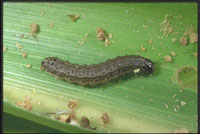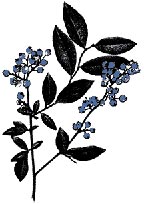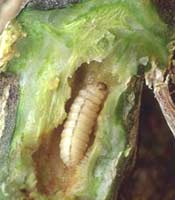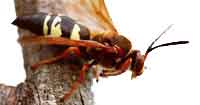

 Please alert us if blue mold is active in your county and we do not have your county listed in this report or on our status maps.
Please alert us if blue mold is active in your county and we do not have your county listed in this report or on our status maps.
UPDATED 6 AUGUST
Blue mold is operating at very damaging levels in many areas of the burley belt and the potential for even greater levels of activity and damage remains in the Ohio River Valley. Economically damaging, first-strike capability now exists from the inoculum load building up in Kentucky. Even areas that do not have blue mold need to appreciate that massive inoculum is available for movement from any of the following areas: Lake Cumberland, Wilderness Trail, Bluegrass, Fort Harrod, and Louisville. As wind patterns shift, that inoculum will be available to cause extensive crop damage. The only means of preventing losses from such events is to have a blue mold program in place before this inoculum arrives. The rapidly growing tobacco from layby to topping is at greatest risk.
Most of what was said in last week's report remains the case, so I will not repeat it here. Below is the status report by area. Most areas now have many counties under a blue mold warning due to active blue mold in the county. Also, if blue mold is present in a county, it is important that samples be collected for oospore assays in order to receive certification for certain export markets. The marketing rules are written such that if blue mold is present, it is presumed that oospores are present unless samples are collected and examined by a lab certified to make this determination.
In counties under a watch, reduce the plant's susceptibility to blue mold by using Actigard 50W if the plants are large enough; otherwise, start sprays with Acrobat MZ. In counties under a warning, at least one spray of Acrobat MZ should be made to reduce inoculum even if Actigard will be used. In fields of young tobacco (prior to topping) with active blue mold, use aggressive spray programs with Acrobat MZ to get the disease under control, plus activate the plant's immune system with Actigard. In fields at the topping stage, Actigard may help improve resistance, but topping and including MH-type materials in the sucker control program are even more important. In a few communities, we have found evidence that metalaxyl-mefenoxam sensitive strains are operating, but in most areas the fungus is highly resistant to the fungicides found in Ridomil Gold and Ultra Flourish. Where sensitive strains are present, that portion of the population can be easily eliminated with applications of these fungicides to the soil.
Foliar fungicide sprays properly made prior to the outbreak or very early on can greatly reduce the potential damage from blue mold. Use Acrobat MZ at 2.5 lbs /100 gallons of water, adjusting the concentration and volume of fungicide to the stage of growth, according to the label. Repeat the applications at weekly intervals. The systemic aspect of this fungicide makes it especially valuable in blue mold control early in the epidemic, because it greatly reduces systemic infections in the lower stem and midribs. It must be applied well and at close intervals when tobacco is growing rapidly to be effective.
Appreciate that in a weeks time, a rapidly growing tobacco plant between layby and topping can increase its growth by 50%, meaning half of the foliage has not received fungicide even when you are spraying on weekly intervals!
Application guidelines for the fungicides labeled for blue
mold control in the field in Kentucky can be found in
Kentucky Pest News, April 28, 2003 issue number 983 at web address -
http://www.uky.edu/Agriculture/kpn/kpn_03/pi030428.htm
For the latest blue mold status and other tobacco disease information, check the KY Blue Mold Warning System online.
![]() http://www.uky.edu/Agriculture/kpn/kyblue/kyblue.htm
http://www.uky.edu/Agriculture/kpn/kyblue/kyblue.htm

 Reports of fall armyworm problems have begun to roll in
from the western portion of the state. These have been
restricted to late planted corn and grain sorghum. Some
fields have had sufficient numbers of fall armyworm to
require treatment. In some instances, fields that were
treated still have high numbers of fall armyworm. The
problem may be that large larvae were the targets of the
treatments.
Reports of fall armyworm problems have begun to roll in
from the western portion of the state. These have been
restricted to late planted corn and grain sorghum. Some
fields have had sufficient numbers of fall armyworm to
require treatment. In some instances, fields that were
treated still have high numbers of fall armyworm. The
problem may be that large larvae were the targets of the
treatments.
Fall armyworm is more of a problem this year due to the large amount of late planted corn. This insect cannot overwinter in Kentucky and must re-invade from the south each year. It prefers to attack sorghum and corn while they are in the vegetative stages. In most years, by the time that the insect has immigrated in sufficient numbers to cause problems, the corn has already tasseled and unattractive. The late planting this year has kept many fields vulnerable later into the season.
Fall armyworm is one of the more difficult to control insect pests in the state. Although the young larvae are relatively easy to control, many infestations are detected late and control of the larger, more difficult to kill larvae is attempted. Older larvae are more difficult to control because they are less sensitive to most insecticides and they bury themselves deep into the whorl below a frass plug that protects them from sprays. Smaller larvae don't produce the plug and need a smaller dose of insecticide for control.
When deciding whether or not to control fall armyworm there are several factors to consider. First, large larvae (1- 1/4" and larger) have already done most of the damage so killing them is of less value and much more difficult. Second, if a field in the whorl stage is to be treated, then sprays need to be directed directly over the whorl with sufficient water to move the spray down into the whorl. Third, late planted corn often does not have the same yield potential as earlier planting dates, therefore, economic thresholds will be to be adjusted upwards.
For more information about corn pests, visit "Insect Management Recommendations".
 Several reports of "worm" infestations of in grain
sorghum or "milo" have come in. We have three
problem worms in this crop in Kentucky. Two, the corn
earworm and the fall armyworm are active now (but will
get worse), the third, sorghum webworm prefers the
cooler weather of September.
Several reports of "worm" infestations of in grain
sorghum or "milo" have come in. We have three
problem worms in this crop in Kentucky. Two, the corn
earworm and the fall armyworm are active now (but will
get worse), the third, sorghum webworm prefers the
cooler weather of September.
If your grain sorghum has not "headed out" yet, see the article on Sorghum Midge in this issue.
Soybean podworms range from " up to 1"" in length. They are usually tan to pale green with several dark stripes down the back. However, color may be quite variable, with some individuals almost black. FAW usually are darker than SPW, have a strip down the side which contains some red or pink splotches (CEW doesn't) and have an inverted 'Y' on their heads (again CEW does not have this).
Fall armyworm will infest whorl stage milo and may be found in mixed populations with corn earworm when the head emerges. This worm is a very bad pest of corn, but is not as damaging to grain sorghum. Milo is just a tougher plant.
Fall armyworm damage to milo will look very much like corn damage. At first you will see "hot hole" feeding that looks like cornborers. Following that stage, feeding damage will be larger and more ragged. Many FAW will be found in each plant.
Insecticidal treatment is warranted if 50% or more of plants have FAW infestations, in the whorl stage. Control problems much like they are in corn. You must get spray down into the whorl to get good control. Us a flooding nozzle over the row and as much water as you can carry. For recommended insecticides see ENT- 24.
Corn earworm may be found as a foliar feeder of grain sorghum, but this is a bit unusual. CEW is usually a pest of the grain head, and will be much more common as surrounding corn fields begin to mature. CEW moths will leave maturing corn and look for later developing crops like grain sorghum and soybean (where we call it the soybean podworm).
Insecticidal control for corn earworm in grain sorghum should be made if you find on average 2 small worms per head.
If you have mixed populations of CEW and FAW the use the 50% infested plants for whorl stage, and 2 small worms per head during the head filling stages, to trigger an insecticidal control.
All of our insecticide recommendations can be obtained from your County Extension Office or on line: http://www.uky.edu/Agriculture/PAT/recs/rechome.htm
 The sorghum midge has the potential to be a devastating
pest on grain sorghum. The pest is usually the greatest
problem on late planted sorghum, and in sorghum fields
that are sequentially planted. Generally speaking, sorghum
planted as a double crop, or planted late because an
original corn planting was lost will be at greater risk than
early full season plantings. Also the further south and west
sorghum is grown in Kentucky, the higher the risk. This is
because of the more "southern" climate, as opposed to
central Kentucky. Johnson-grass is also a host for this pest
so infested fields will be more at risk than fields clear of
Johnson-grass.
The sorghum midge has the potential to be a devastating
pest on grain sorghum. The pest is usually the greatest
problem on late planted sorghum, and in sorghum fields
that are sequentially planted. Generally speaking, sorghum
planted as a double crop, or planted late because an
original corn planting was lost will be at greater risk than
early full season plantings. Also the further south and west
sorghum is grown in Kentucky, the higher the risk. This is
because of the more "southern" climate, as opposed to
central Kentucky. Johnson-grass is also a host for this pest
so infested fields will be more at risk than fields clear of
Johnson-grass.
Sorghum midge may be present in production fields from boot stage through the remainder of the year. However, midge is ONLY A PROBLEM DURING BLOOM !! The sorghum midge lays its eggs in the open bloom. The maggot hatches and immediately enters the kernel, hollowing the kernel out from the inside. No damage will be seen until much later in the season when the kernels begin to fill out.
Sorghum midge is a very small fragile fly. This 1/8" long orange insect may be confused with winged aphids. However, most of the aphids will be black or dark green. Also when winged aphids appear colonies and un-winged individuals will be present.
Scout for Sorghum midge early in the day generally before 10 AM. They will not be present in the hottest part of the day. Check twenty heads in each location. Place a clear plastic bag over the head and shake the head. Carefully remove the bag and examine it against a light background. Look for small, orange, fly-like insects.
The treatment threshold is an average of one, sorghum midge per head. If you detect a population equal or greater DURING SORGHUM BLOOM an insecticide application should be considered.
Midges are not difficult to control. See ENT-24 for insecticides that may be used. You will not see symptoms until it is too late!
 Kentucky blueberry growers sometimes experience plant
and crop losses due to diseases. Most losses are due to root
rot or to stem and twig canker diseases. With good crop
management, most blueberry diseases can be avoided.
The following are diseases found on Kentucky
blueberries.
Kentucky blueberry growers sometimes experience plant
and crop losses due to diseases. Most losses are due to root
rot or to stem and twig canker diseases. With good crop
management, most blueberry diseases can be avoided.
The following are diseases found on Kentucky
blueberries.
Blueberry disease management.
In some circumstances, canker diseases have devastated Kentucky blueberry plantings. In most of these instances, plants were growing under stressful conditions such as drought or high pH soils. For most Kentucky locations, blueberry diseases are not a serious problem as long as the site is well-drained, the soil pH is near 5.0, the soil has adequate organic matter, good sanitation pruning practices are used, and the plants are watered regularly during dry periods. With good growing conditions and following good cultural control practices, use of fungicides can be minimized.
Disease management advice can be found in U.K. Cooperative Extension Publication ID-94, Midwest Commercial Small Fruit and Grape Spray Guide 2003 and the Midwest Small Fruit Pest Management Handbook available at Kentucky County Extension Offices.
The squash vine borer is a key pest of winter squash, gourds and pumpkins in Kentucky. Unfortunately, it is usually noticed only after it has done its damage. Symptoms appear in mid-summer when a long runner or an entire plant wilts suddenly. Infested vines usually die beyond the point of attack.
 Sawdust-like frass near the base of the plant is the best
evidence of squash vine borer activity. Careful
examination will uncover yellow-brown excrement
pushed out through holes in the side of the stem at the
point of wilting. If the stem is split open, one to several
borers are usually present. The caterpillars reach a length
of 1 inch and have a brown head and a cream-colored
body.
Sawdust-like frass near the base of the plant is the best
evidence of squash vine borer activity. Careful
examination will uncover yellow-brown excrement
pushed out through holes in the side of the stem at the
point of wilting. If the stem is split open, one to several
borers are usually present. The caterpillars reach a length
of 1 inch and have a brown head and a cream-colored
body.
The adult squash vine borer is a stout dark gray moth with 'hairy' red hind legs, opaque front wings, and clear hind wings with dark veins. Unlike most moths, they fly about the plants during the daytime, appearing more like a paper wasp than a moth. Adult moths begin to emerge about the time the plants begin to run, and moth flight continues through mid August. The small brown eggs, laid individually on leaf stalks and vines, hatch in seven to 10 days. The newly hatched larva immediately bores into the stem. A larva feeds for 14 to 30 days before exiting the stem to pupate in the soil.
The key to squash vine borer management is controlling the borers before they enter the stem. Once inside the vine, insecticidal control is ineffective. Poor timing of sprays is the usual cause of inadequate control. Monitor plants weekly from mid-June through August for initial signs of the borer's frass at entrance holes in the stems. Very early signs of larval feeding indicate that other eggs will be hatching soon. Use two insecticide applications 7 days apart to control newly hatching larvae and continue to monitor for additional activity. Sprays need to penetrate the canopy to cover the vines to be effective.

Emerald 70WG is labeled only for use on golf course turfs; it is not labeled for other turf uses nor for other crops. Emerald 70WG is labeled for control of dollar spot and bentgrass dead spot. Dollar spot is much, much more common in Kentucky than is bentgrass dead spot. Indeed, more fungicide is used for dollar spot control than any other turfgrass disease, so it is significant that boscalid has a different biochemical mode of action from other dollar spot fungicides. What this means is that boscalid poisons the cells of the dollar spot fungus in a way that is different from DMI fungicides (Banner, Eagle, etc), benzimidazoles (Cleary's 3336, etc), or dicarboximides (Chipco 26GT, Vorlan, etc). This is important for two reasons:
For dollar spot control, Emerald 70WG is labeled at 0.13 to 0.18 oz/1000 sq ft, to be applied at 14- to 28-day intervals. To BASF's credit, they have been researching this product for several years at numerous locations including Kentucky, so there is a substantial (and growing) body of published work evaluating the efficacy of Emerald 70WG. In published reports, Emerald 70WG consistently has provided excellent control of dollar spot when used preventively at the 0.13 oz rate at 2-week intervals. Although the use of 0.18 oz for 3 to 4 weeks provided excellent control in several studies, disease control did sometimes slip at these extended intervals in other studies. Boscalid is in a family of fungicides called "carboxamides" or "anilides", which are regarded as having a moderate risk of resistance. In drafting the current label, BASF took a justifiably cautious approach by permitting only two sequential applications of Emerald 70WG before superintendents must rotate to another effective dollar spot fungicide. After that application has run it's course, Emerald 70WG can be reapplied. I cannot stress enough how important it is to follow this guideline. It is mandated by the EPA-approved label, and it will reduce the risk of resistance buildup to boscalid on your course.
The label for Emerald 70WG provides a "Surface Water
Advisory", warning users of a potential to contaminate
surface waters either by drift on a windy day or in
surface runoff. There are several ways to reduce the
potential for runoff: Have vegetated buffer strips
between areas receiving application and surface waters,
and minimize applications within 48 hours of forecasted
rainfall.
 Cicada killers have been flying around and burrowing
into lawns, prompting calls from homeowners. Despite
their menacing appearance (up to 2 inches long with
rusty red head/thorax, amber-yellow wings, and black
and yellow striped abdomen), the wasps seldom sting
unless handled or molested.
Cicada killers have been flying around and burrowing
into lawns, prompting calls from homeowners. Despite
their menacing appearance (up to 2 inches long with
rusty red head/thorax, amber-yellow wings, and black
and yellow striped abdomen), the wasps seldom sting
unless handled or molested.
---Biology - Cicada killers do not live in communal nests like hornets or yellowjackets. They overwinter as larvae within cocoons deep in the soil, emerging as adults during July. The females feed, mate, and excavate burrows in the ground about " inch in diameter, ending in a series of brood chambers. Bare ground or sand are especially prone to infestation. Excess soil is pushed out of the burrow, leaving a U-shaped mound of dirt at the entrance. Each female excavates numerous burrows and provisions them with adult cicadas which she ambushes, paralyzes with her venom, and stuffs into individual brood chambers. She then lays an egg on top, backs out, and seals the cell behind her. The egg hatches within a few days and the hungry larva devours the offering, eventually transforming into an adult the following summer.
---Management - Cicada killers seldom sting and the females normally do not defend their burrows. The males, while incapable of stinging, sometimes dive-bomb passers-by, or hover menacingly nearby. Insecticide treatment may be warranted where the soil burrows become unsightly or the wasps are digging in a high-traffic area, such as along a sidewalk, the entrance to a building, or a sand trap on a golf course. Individual burrows can be effectively sprayed or dusted with most lawn & garden insecticides (Sevin, Bayer Advanced Lawn & Garden Multi-Insect Killer, Spectracide Triazicide Soil & Turf Insect Killer, etc.) or a wasp & hornet aerosol spray. Large numbers of nests may need to be treated with a broadcast application to the ground surface, in which case an insecticide concentrate formulation will be most convenient applied with a pump up or hose-end sprayer.
As a long-term solution against future nesting, clients should be advised to eliminate bare-ground areas. Cicada killers generally do not prefer to burrow into well- managed turf, gravel, pebbles or mulch. In some situations, such as playgrounds, camping areas, or commercial landscapes, these materials can be substituted for sand or bare soil as a deterrent to future burrowing. The other option for now is to wait and do nothing in a few weeks or so the adults will die off and there's a chance the problem may not reoccur next year.

Last week in the Diagnostic Laboratory, we diagnosed boron deficiency on alfalfa; southern blight, stem canker (Rhizoctonia), downy mildew and manganese deficiency on soybean; maize dwarf mosaic virus on sorghum; angular leaf spot, blue mold, frogeye leaf spot, black shank, alfalfa mosaic virus, tobacco ringspot virus, and manganese toxicity on tobacco.
On fruits and vegetables, we diagnosed double blossom (rosette) on blackberry; cedar-apple rust and frogeye (Botryosphaeria) on apple; anthracnose and Rhizoctonia stem canker on bean; anthracnose on cantaloupe; powdery mildew on zucchini; bacterial canker, early blight, Septoria leaf spot, Fusarium wilt and blossom end rot on tomato.
On ornamentals and turf, we saw charcoal rot on chrysanthemum; leaf streak and anthracnose on daylily; Septoria leaf spot on dogwood; iron deficiency on oak; Rhizosphaera needle cast on spruce; summer patch on Ky. bluegrass; Pythium root rot and anthracnose on bentgrass; inflorescence smut on bermudagrass; and brown patch on tall fescue.

UKREC-Princeton, KY, July 25-August 1, 2003 | Black cutworm
| 1
| True armyworm
| 18
| Fall armyworm
| 35
| European corn borer
| 2
| Southwestern corn borer
| 139
| Corn earworm
| 105
| | |
NOTE: Trade names are used to simplify the information presented in this newsletter. No endorsement by the Cooperative Extension Service is intended, nor is criticism implied of similar products that are not named.
Lee Townsend
Extension Entomologist